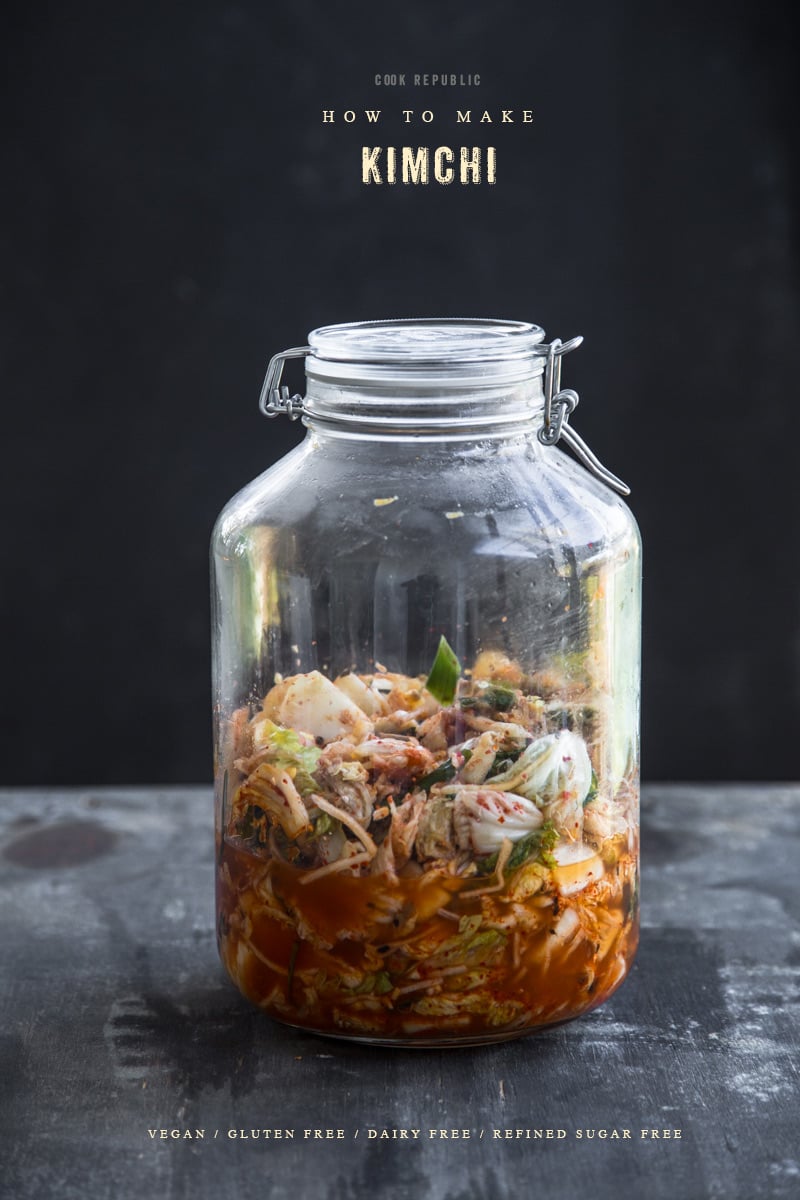
If cabbage ever had to claim its fame, it would be for Kimchi. A spicy Korean fermented pickle with a punchy sour flavour to tickle your giblets and enough tartness to make you sassy mouth, the Kimchi has a fanatic global following which has been amplified by its status as healthy gut food. It is no secret that fermented food is good for you. The good bacteria that are the hallmark of fermented foods not only heal your gut (the largest organ in your body and a crucial one to your overall health and well being), they aid in digestion, weight loss and balancing the acids in your stomach.
Over the years this traditional art of food preparation has dwindled but with the new awareness for health and nutrition sparking books, blogs and conversations everywhere, fermented foods have got a new lease on life. I have grown up on fermented foods, the traditional steamed lentil cakes (dhokla) a staple in my mum's kitchen. With pickling an annual event on my maternal terrace, everyday fermented pickles made with fresh turmeric and ginger were fed to us with folklores of how they destroyed demons and won wars.
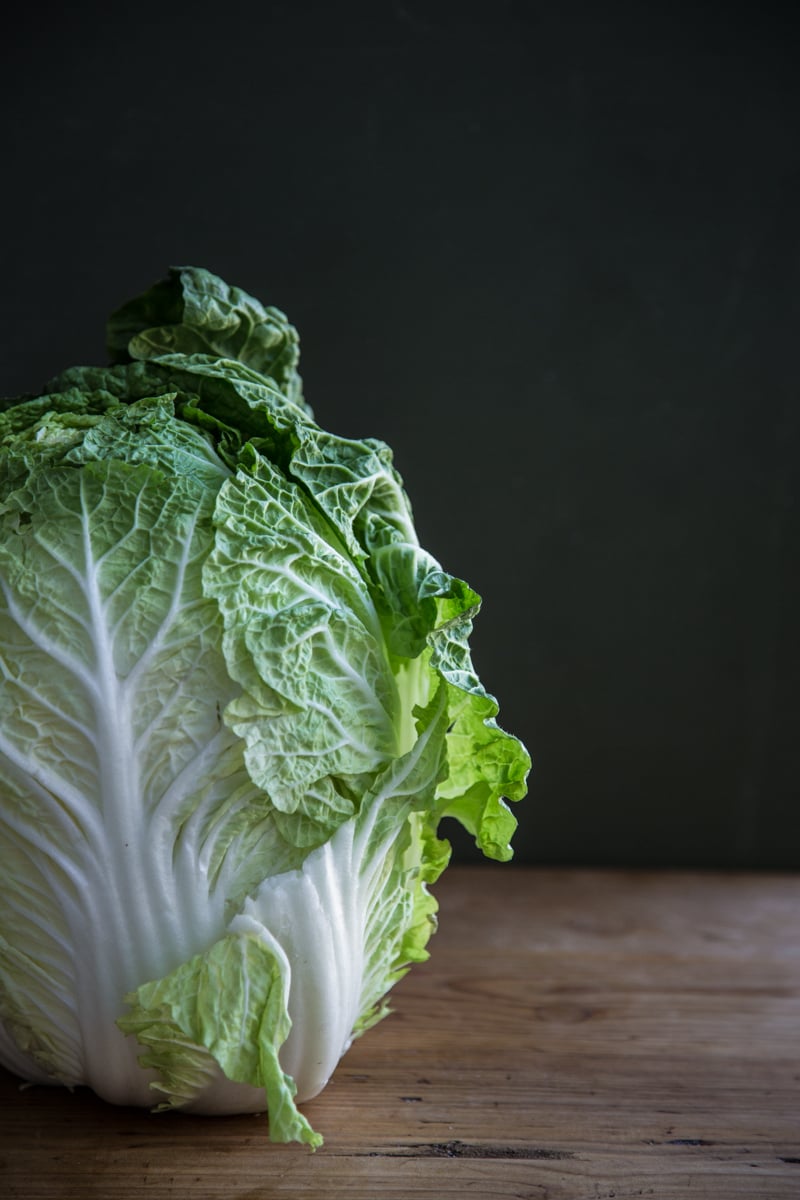
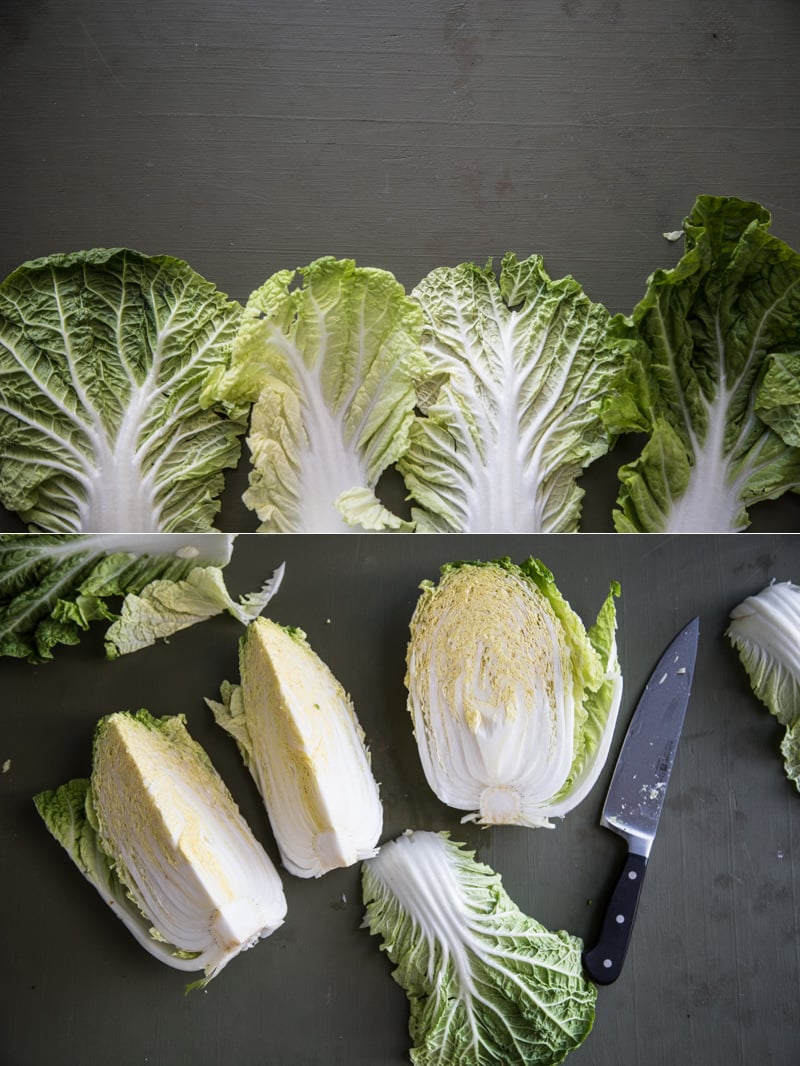
Kimchi, a relatively new fermented food in my culinary repertoire is no different from all the probiotic goodness I have been sampling over the years from strained yoghurt to bread and everything in between. It is a labour of love like everything else and is completely customisable. With the title of being Korea's national dish, kimchi has spawned as many fans as it has variations with hip young chefs taking it to a new level by making it from every vegetable imaginable and incorporating it in desserts and cocktails (the verdict is still out on that!). Most kimchi (also kimchee or gimchi) is made with fish sauce to give it that unique tangible umami taste. I wanted to make my kimchi vegetarian/vegan and so I experimented with flavours notorious for that elusive fifth taste known the world over as "umami" (after sweet, sour, salty and bitter). I finally managed to nail it down to a combination of mushroom and seaweed which made this batch of kimchi completely vegan and utterly delicious.
You need a big giant Napa cabbage fondly known as Wombok here in Australia, approximately 1.2 to 1.5kg in weight. You will also need a big giant glass jar. I have recently invested in a small army of Fido glass jars with amazing suction tops and some good mason jars in all sizes. They are not only great for everyday smoothie drinking and pantry storage but make very reliable fermentation buddies. I used a 5 litre jar for my kimchi experiment which was big enough to house all the fermentation gases without exploding the top. The heat in this recipe is just right, not at all spicy for my taste which is why I will increase it by adding a teaspoon of pure chilli powder to my batch the next time. But this is exactly what I have found in some of my favourite Korean dining restaurants.
Have you tried making kimchi before? If not, tonight might be a good time to start and come Sunday you will have a big brilliant batch of kimchi to eat and cook with. If you are pressed for time, try my super quick instant 30-Minute Kimchi made with Vegan Fish Sauce (secret ingredient alert!)
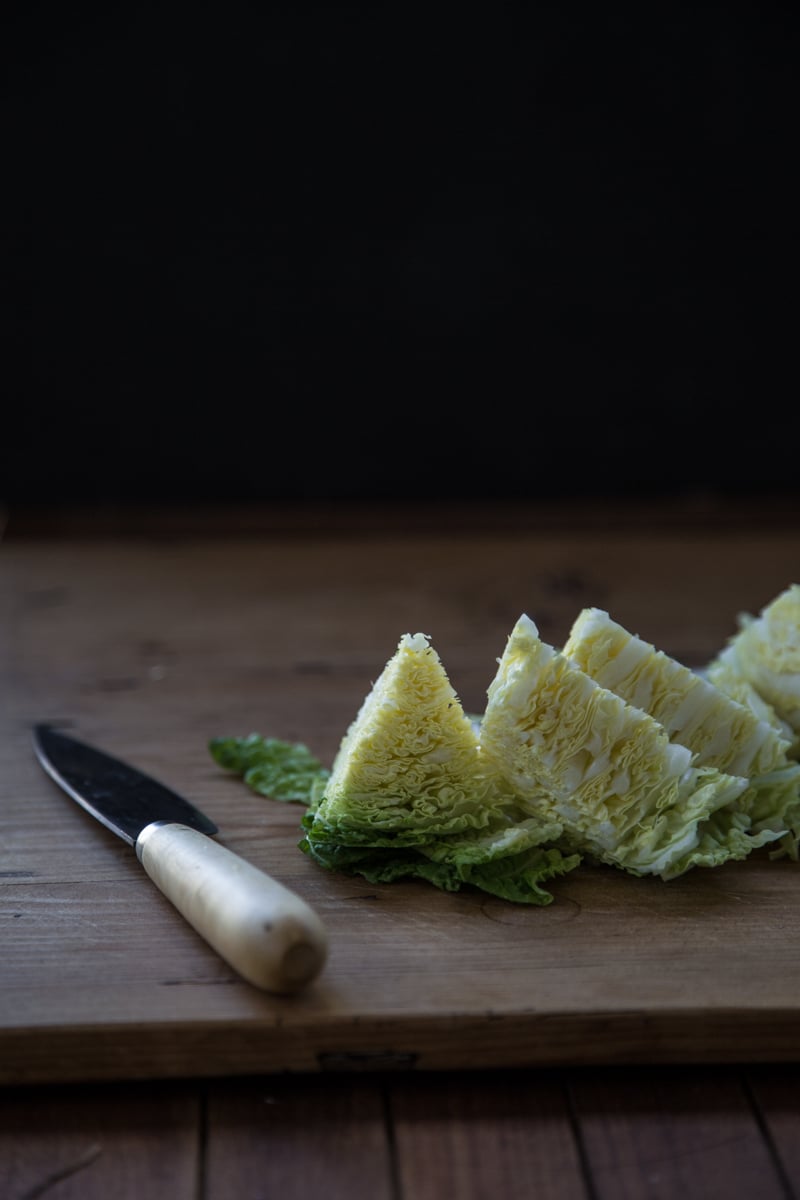
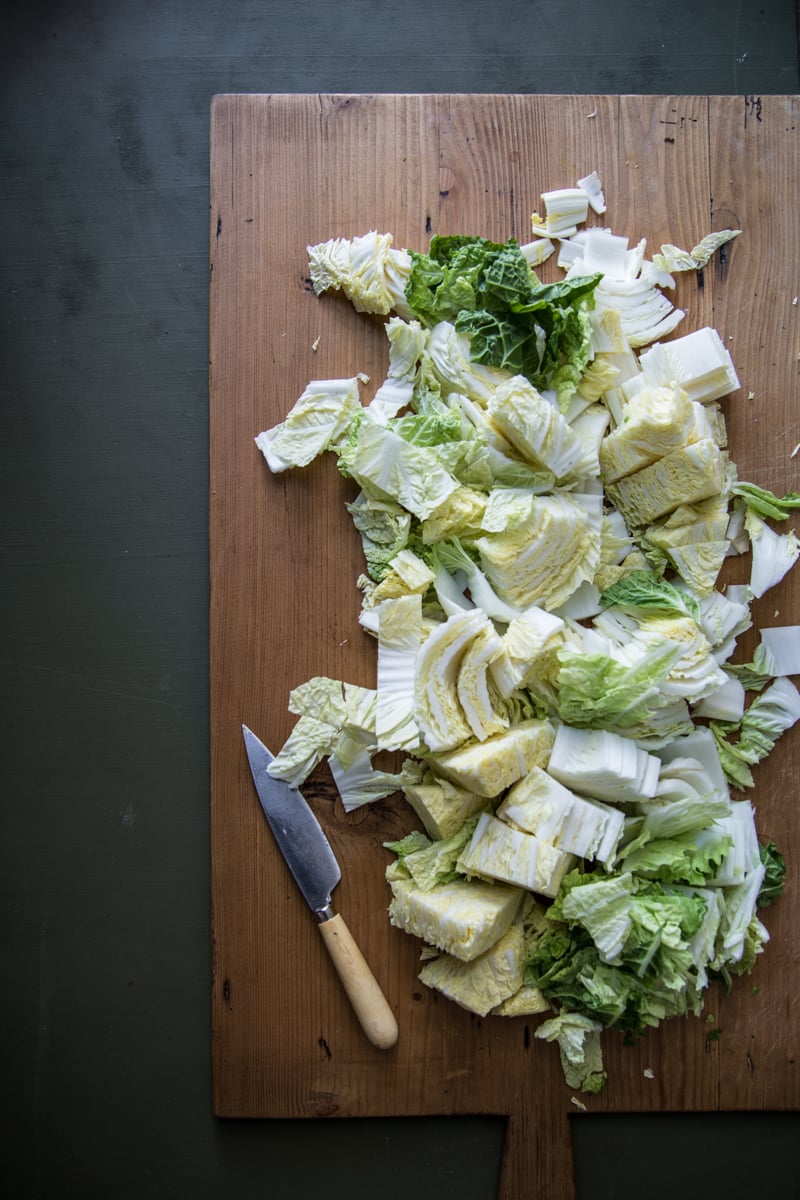
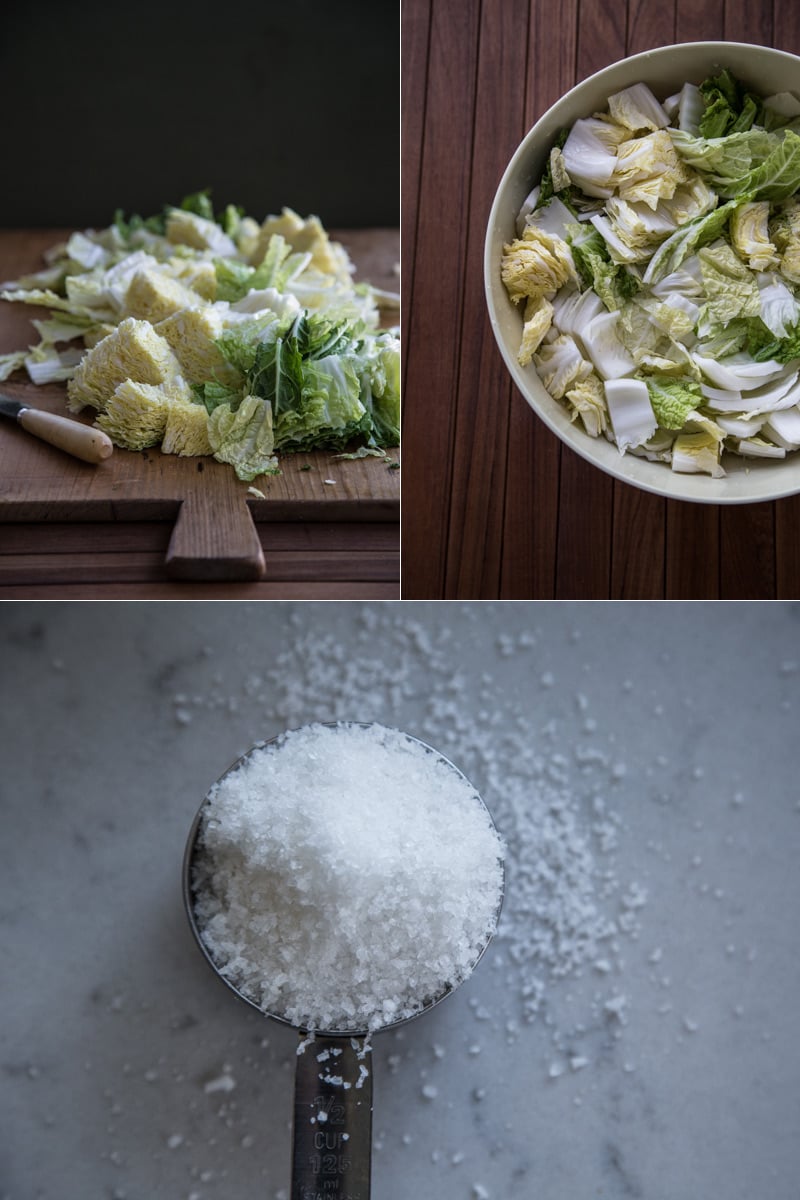
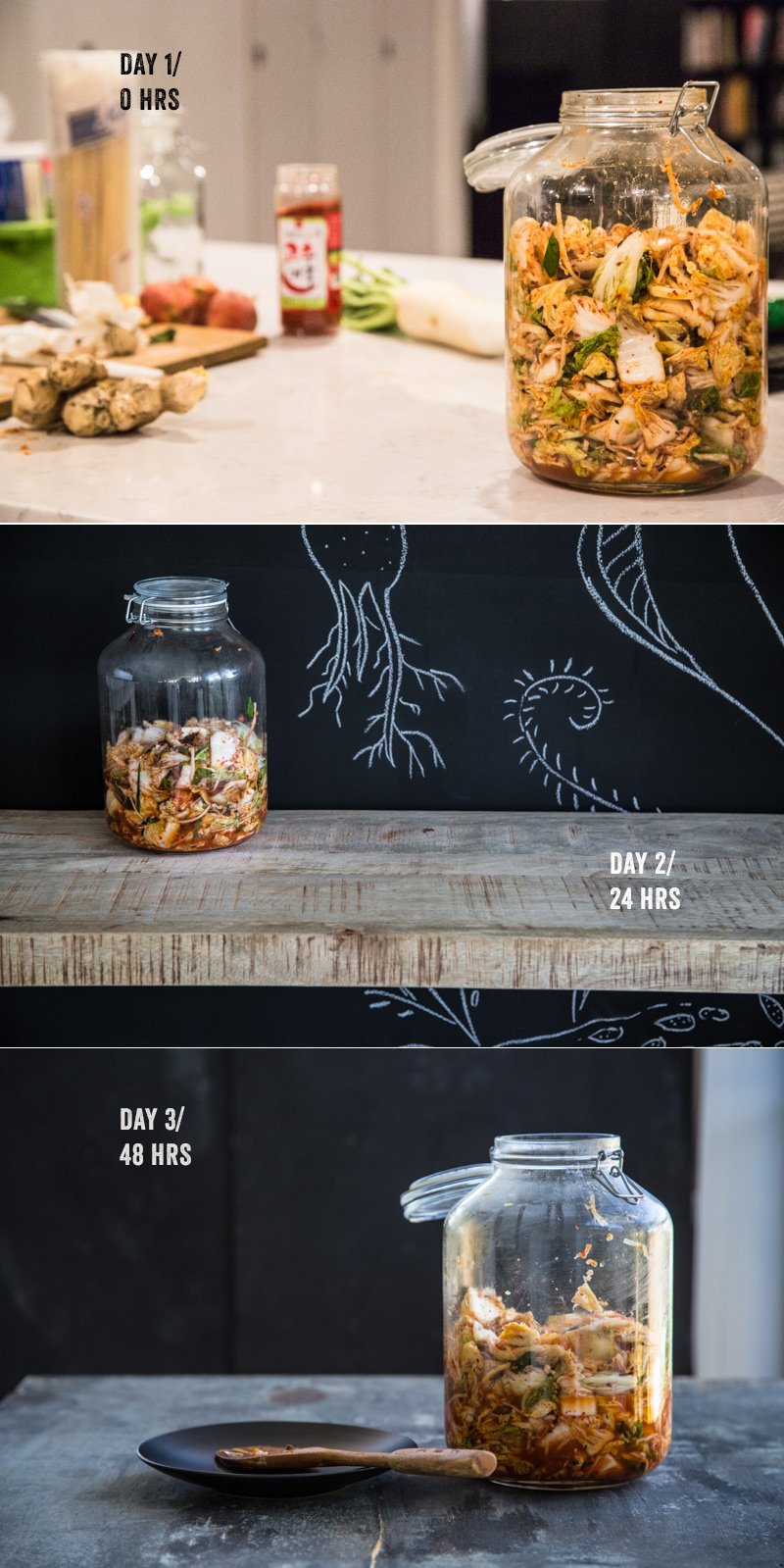
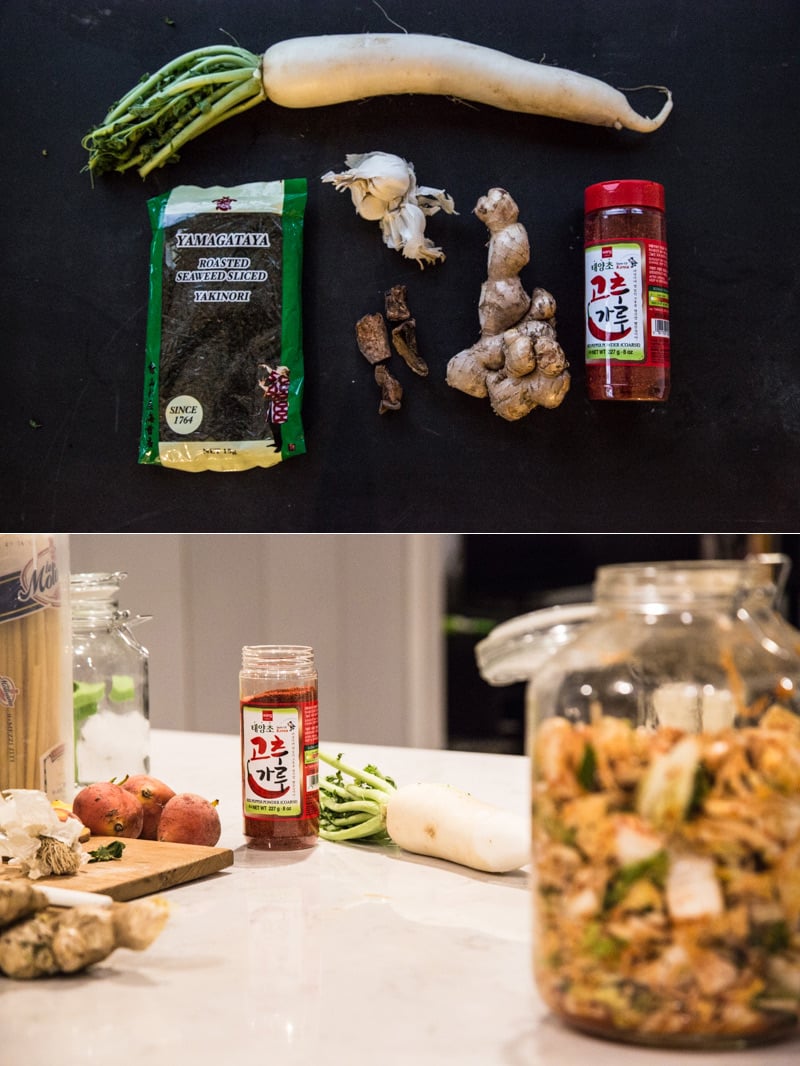
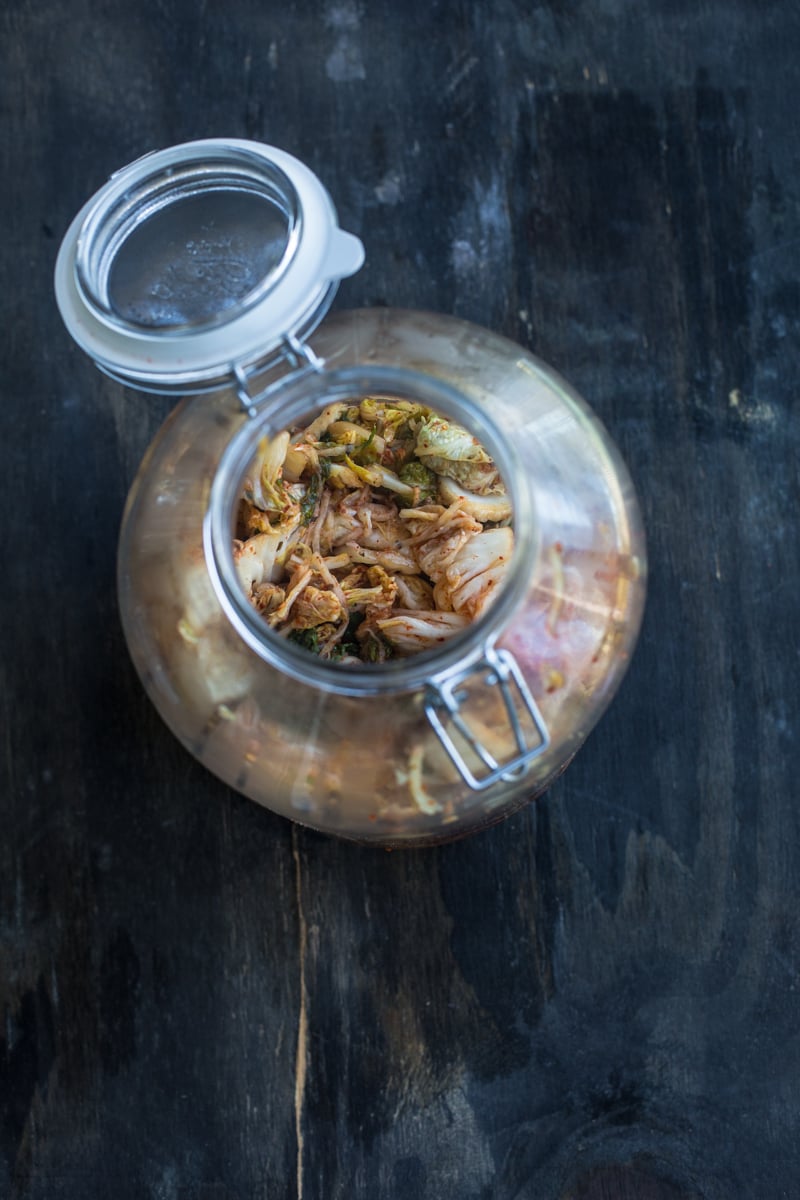
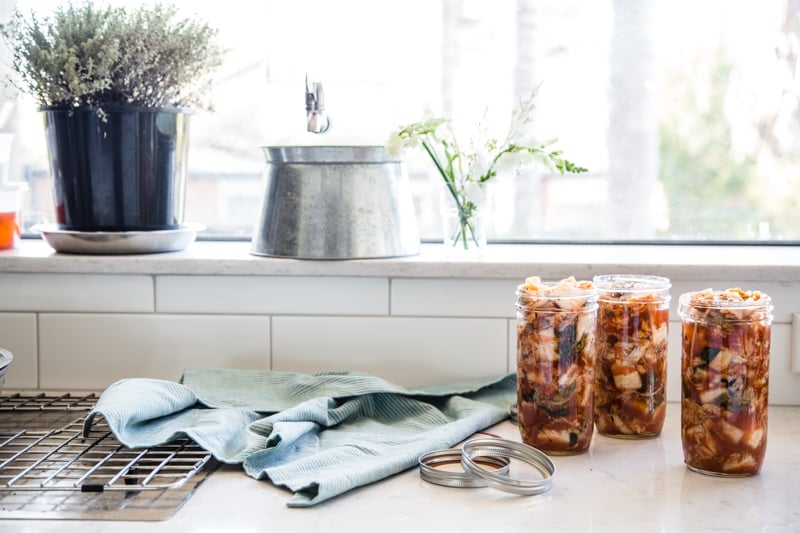
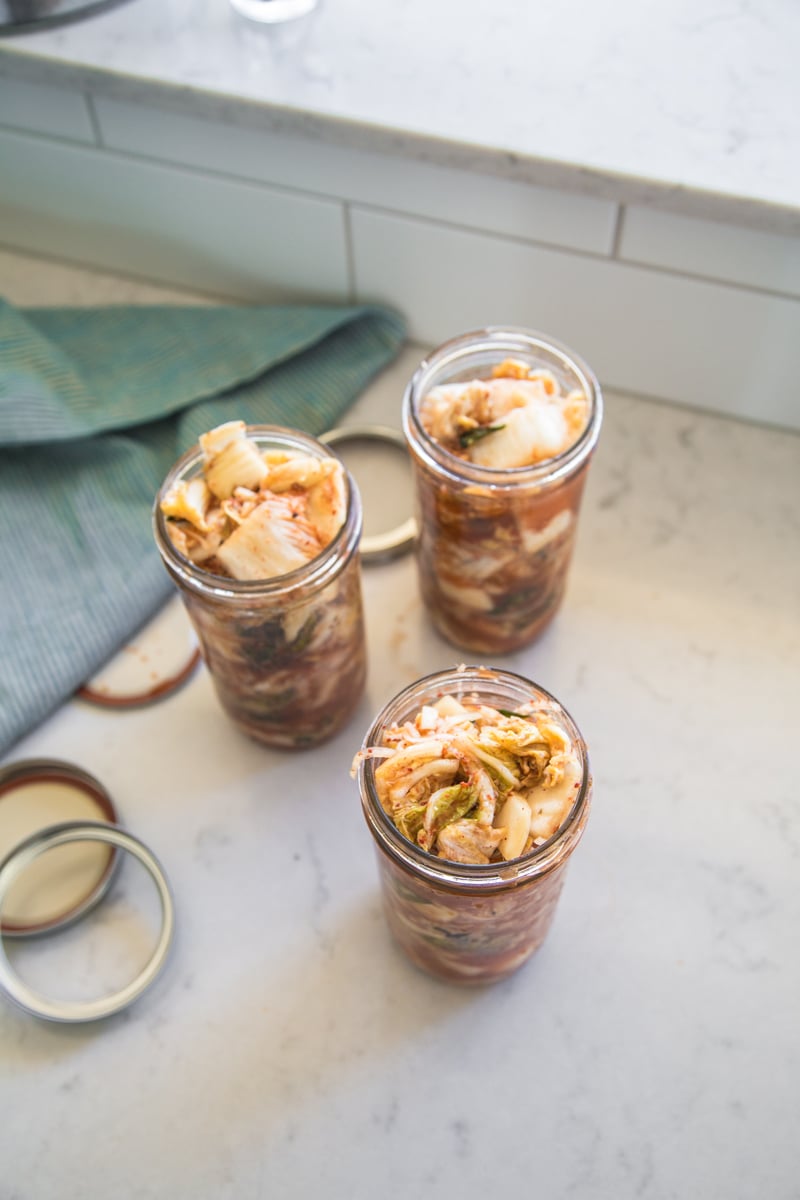
Recipe
Hungry For More Recipes? Subscribe to my newsletter. Check out Facebook, Instagram and Pinterest to see everything I share! And if you love cooking and new cookbooks, join my free Cooking Club on Facebook!
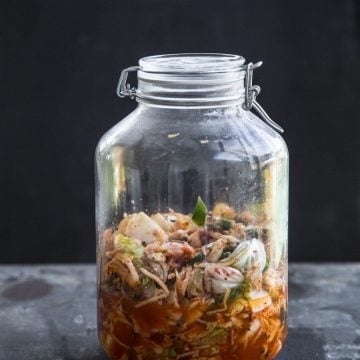
HOW TO MAKE VEGAN AND GLUTEN FREE KIMCHI
Ingredients
- 1 Napa cabbage, wombok/wong bok/Chinese leaf/asian cabbage quartered lengthways and sliced into 2 inch pieces
- 1/2 cup salt
- 12 cups water
- 2 tablespoons Korean pepper powder*
- 1 tablespoon raw sugar
- 1 1/2 tablespoons chopped dried porcini mushroom
- 1 tablespoon chopped nori, dried seaweed
- 8 garlic cloves, minced
- 2 tablespoons fresh grated ginger
- 1 cup grated/ribboned white radish
- 2 chopped spring onions, whites and greens
Instructions
- Place chopped cabbage, water and salt in a super large bowl. Press down on the cabbage to make sure it is submerged under the salted water. Cover with cling wrap (put some weight on top if you have to). Soak overnight or at least 8 hours.
- Prepare all the other ingredients and place them in a small bowl. Unwrap the cabbage bowl and drain all the water. Remove the cabbage into separate super large bowl. Add the spice and radish mix to the cabbage and mix gently with your hands until the cabbage is thoroughly coated with the spices.
- Spoon the cabbage mix and any liquid that has accumulated in a large 5 litre glass jar with a tight lid. (I used a 5 litre Fido jar with a flip top suction lid). Secure the lid tightly and place the jar in a quiet corner of your kitchen. Within the first half an hour, you will notice the cabbage settling down as it sweats and more liquid is released. An hour later, the level of the cabbage would have sunk further. Leave the jar to rest undisturbed in this spot for 48 hours. During this time, you will notice that the empty space in the jar is starting to get cloudy. This is the beautiful fermentation gases brewing and working their magic to create a tart kimchi.
- After the 48 hours have passed, your kimchi is ready to eat. If you desire a stronger tasting kimchi, rest the jar for another day or two. Once you are satisfied with the taste, spoon the kimchi in all it's glory into a large 3 litre jar or three 1 litre jars and store in the fridge for up to 3 or 4 weeks.



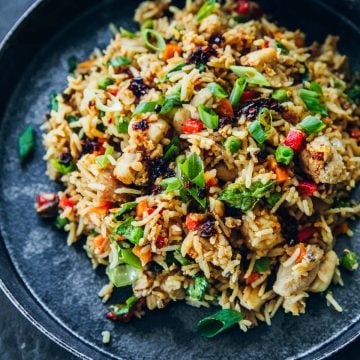
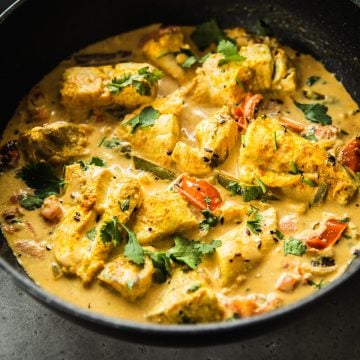
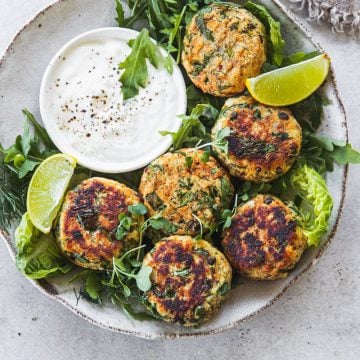
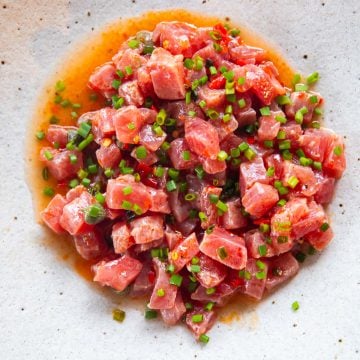
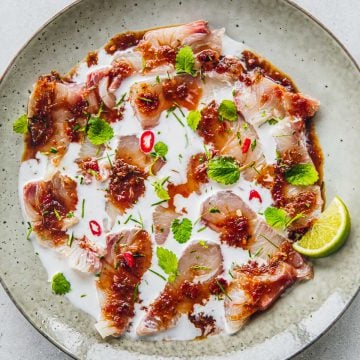
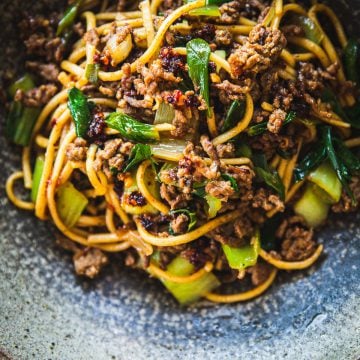
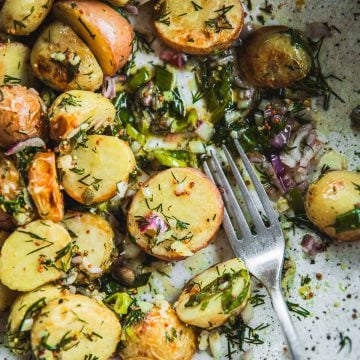

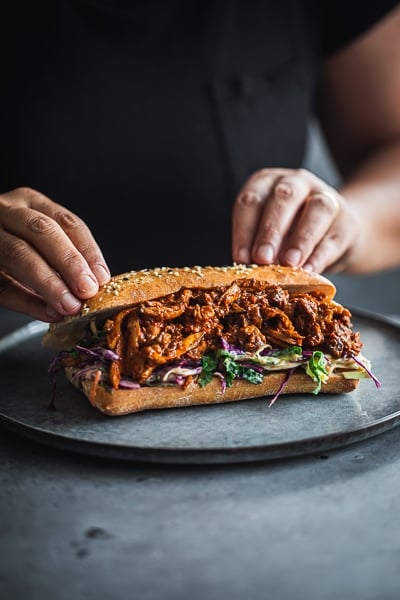
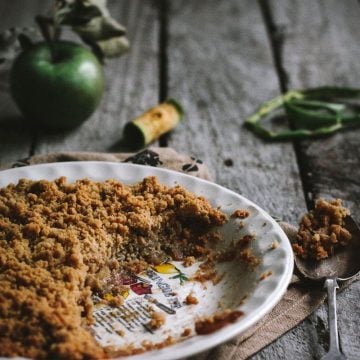
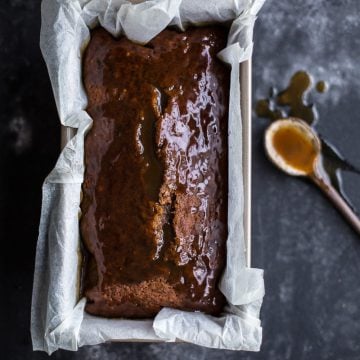
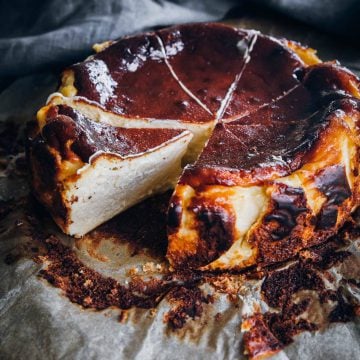

These Kimchi looks so zesty and tasty! Absolutely love your creative idea! Thanks, for sharing!
I'm wondering how the 'sauce' ends up as you don't make the rice 'goo' to mix with the chilli and spices... does it end up being thin? I've always made it with the paste, and so the kimchi has a nice clinging sauce on it.
There are as many Kimchi recipes as there are Korean Grandmothers... Being a vegetarian, makes it hard to get that flavour, so thanks for the tips - I didn't know you could pickle seaweed - I love wakame and usually have vego seaweed soup for breakfast; replacing the meat with the black wood ear mushrooms.
I'm in Australia and always knew Napa cabbage as Michihili (Japanese) rather than the Wonbok, in case anyone gets confused!
Gloria, the sauce is not thin at all, it hugs the cabbage nicely. The rice flour in the paste I make early in the recipe gives it that thick saucy quality.
I am giving your recipe 5 stars, even though I have not made it yet. I have made enough kimchi over the years to know this one is a winner 🙂 I would like to add: You can avoid using cane sugar if you puree 1/2 of an apple and 1/2 of a pear. That will provide enough natural sugar for the fermentation to take place, and it adds a nice flavor to the final product. I learned that trick from an on line Korean holistic doctor.
Mangchee teaches making a rice porridge for the ginger garlic onion chili mix. I think it provides a nice base for the big flavors, kinda like how adding fat will fix a soup that is over seasoned.
Hi, Can I use nori sushi sheets for the dried nori? I know they are roasted but I cannot get any other here. Thanks!
I make it just to avoid MSG from the store bought versions. http://earthlychow.com/tired-kimchi-msg-make
Hi. Thanks for this recipe. I'm trying it! I have one question I can't seem to find the answer to: where do the probiotics come from? what makes the kimchi ferment?
Hi Lauren, hope you like this kimchi. It is quite fail safe. The fermentation happens with a bit of scientific trickery due to the process involved called lacto-fermentation. As you know everything has good and bad bacteria. The salt brining method is to kill off the bad bacteria. Meanwhile the good bacteria pair up with the sugar to create lactic acid which preserves the vegetable and gives it that amazing tangy taste. The probiotics are created as a result of this wonderful process. x
Thanks Snehroy! I made it and it came out great! I'm just clarifying; so the good bacteria/probiotics are from the cabbage in the first place? I was just confused because usually some type of culture is added to ferment foods.
No worries Lauren. True, but not always. This is a natural process where the probiotics are formed due to a clever combination of ingredients. Just like the yeast that forms naturally when you create a sourdough starter )as opposed to the commercial yeast you can buy from the stores) 🙂
Hi there I have just put the kimchi in the fermentation jar. I have read some other recipes that say to submerge the kimchi in liquid, will it still work without doing this? Also what are your thoughts on salting the cabbage without water- allowing the cabbage to wilt before fermenting? Many thanks.
Nice photos and the all steps to make Kimchi you described here are quite simple to understand. KImchi is actually my favorite food that I mostly eat and enjoy in a restaurant.
Wow. What beautiful photos. Love the detail of the presentation on kimchi-making. Hopefully I can find all those other ingredients at the local supermarkets...
Interesting recipe. Will have to put it on my recipes to try list 🙂
Can't have a complete Korean meal without the condiments i.e Kimchi.
Nice work.
Hi Sneh,
I tried this once in Bali last year, and have wanting to find a great recipe. This looks awesome and I can't wait to try it. Thanks for sharing. BTW amazing photos.
I love kimchi, it's so nice as a side dish that just adds a bit of healthy vegetables into a meal. One of my (Korean) friends actually has two fridges at home - one of them specifically for kimchi! It's pretty funny.
Do you take all these pictures yourself? They're amazingly good!
Gorgeous as always, and I can't wait to try this!
I had kimchi beef the other day and it was delicious! Nice to know that I can make it from scratch!
Yum! I can't wait to try this recipe, and I do agree, the humble cabbage has found it's claim to fame. Gorgeous images all the way through this story too.
Thanks for sharing.
Julie
Gourmet Getaways
I've never made kimchi at home but I've always thought it would be fun. You make it look easy too.
Something I always wanted to try, now in winter is probably the best time for us to give it a go. I remember my dad having some bad misses with Sauerkraut, it was just too warm for it in Namibia. By the way, your new kitchen is very photogenic 🙂
I have never been good at pickling. But this post of yours has inspired me to try pickling. Your kimchi looks beautiful sneh. And the pictures are simply gorgeous!
Do you think you could use a normal cabbage instead of the wombok? I can't wait to make my own kimchi.
I love kimchi and have made it only once myself. Will have to try again...
Cheers,
Rosa
Last night just as I was in bed, trying to fall asleep, I thought to myself, "ahh I should look up some vegetarian kimchi recipes." And this afternoon when your blog update popped up in my email, I was like YAY! I'll definitely give this recipe a go. Your kimchi looks yummmm!!
this looks incredibly do-able !
Sneh - I love kimchi but had always thought it would be a difficult process to make. You have well and truly proven otherwise! OK - I have to 'invest' in a 5-litre jar and get some Korean pepper powder, which I am certain will not be difficult!! Have all for your alternate version one ingredients anyways!! An interesting weekend endeavour and I am certain 'home made' will taste best 🙂 !
Great looking kimchi Sneh! Love that it's vegetarian/vegan. Great that you've used mushrooms and seaweed/kobu - two of my favourite umami ingredients. Home-made pickles are so rewarding and taste so darn fine, and I'm sure this kimchi recipe is the same. Looking forward to trying it. Your photos are so lovely! 🙂
This is so awesome and I so excited to try it. Beautiful photos!